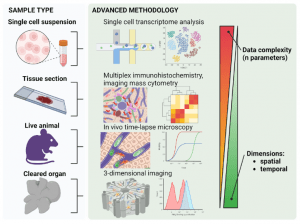In a recent review, researchers have described the hepatic immune landscape, focusing particularly on the dynamic nature of liver macrophages and their significance in various liver diseases (Figure 1).

Figure 1: Recent technological breakthroughs greatly advanced our understanding of liver macrophage spatiotemporal diversity. For instance, single-cell suspensions subjected to single- cell transcriptome analysis revealed the simultaneous presence of multiple immune cell phenotypes. Multiplex immunohistochemistry and imaging
mass cytometry showed complex and spatially restricted accumulation of defined monocytic populations. In vivo time-lapse microscopy unravelled the timing of the immune response and dynamic macrophage functionality. Organ clearing and three-dimensional imaging further deepened in situ macrophage biology understanding.
The liver, a vital organ, is home to a diverse array of macrophages, pivotal components of the innate immune response that also play essential roles in maintaining the organ’s health. Two distinct populations dominate this macrophage composition: liver resident macrophages, known as Kupffer cells (KCs), and monocytic macrophages originating from the bone marrow (MoMFs). These macrophage populations vary in origin and function, contributing to the liver’s equilibrium under normal conditions and during disease progression.
The researchers spotlight the significance of phenotyping liver macrophages based on their spatial distribution, emphasizing its value in liver disease-related research. Notably, the distribution of these macrophage populations changes markedly as liver disease evolves.
In later stages of liver diseases, notable transformations occur. Kupffer cells (KCs) experience depletion, while perilobular fibrotic areas exhibit an accumulation of monocytic macrophages (MoMFs) with heightened pro-inflammatory traits and impaired phagocytosis capabilities. Conversely, in fatty liver disease, lipid-associated macrophages make their presence felt in steatotic regions.
This comprehensive review sheds light on the intricate interplay between these diverse macrophage populations within the liver and their pivotal roles in both health and disease.
Journal article: Guillot., A., et al. 2023. Spatial dimension of macrophage heterogeneity in liver diseases. eGastroenterology.
Summary by Stefan Botha










